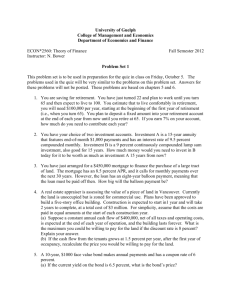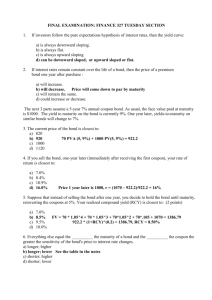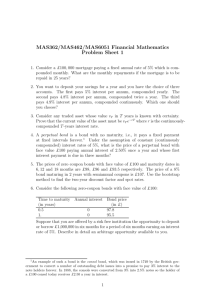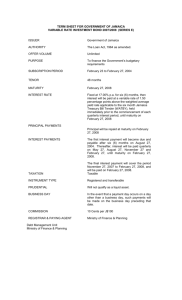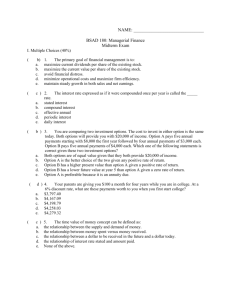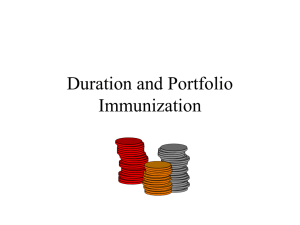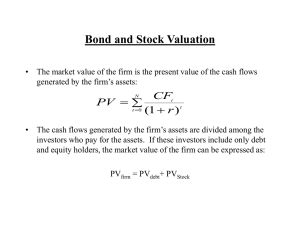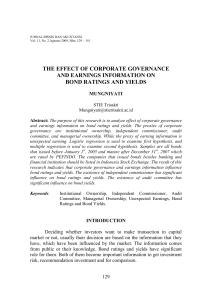Personal Finance Literacy Exam Study Material
advertisement
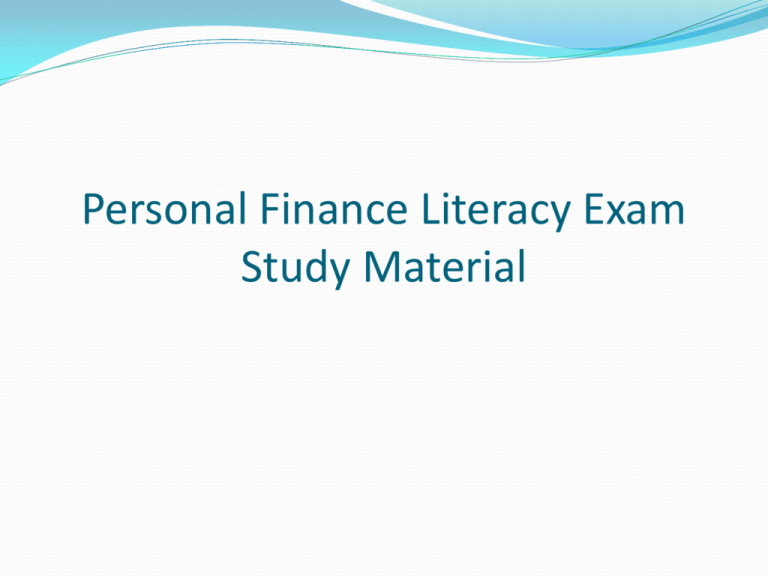
Personal Finance Literacy Exam Study Material Steps in Career Planning Self-analysis 2. Research 3. Plan of action 4. Re-evaluation 1. Chapter 2 SLIDE 2 The Importance of Goals A goal is a desired end toward which efforts are directed. Goals provide a sense of direction and purpose in life. There are three types of goals: Short-term goals are one you expect to reach in a few days or weeks. Intermediate goals are those you wish to accomplish in the next few months or years. Long-term goals are those you wish to achieve in five to ten years or longer. Chapter 2 SLIDE 3 References References are people who have known you for at least a year and can provide information about your skills, character, and achievements. References should be over age 18 and not related to you. The best types of references include teachers, advisors, current and former employers, counselors, coaches, and adults in business. Be sure to ask permission before listing people on your resume. Chapter 3 SLIDE 4 Effective Communication at Work Success on the job depends on good communication skills. Of all the job activities you perform in a day, 80 percent involve communication in one form or another. More than half of all job communication involves listening and speaking. Many job ads list good communication skills as a must. Chapter 4 SLIDE 5 Social Security Forms Social Security Number Your Social Security number is your permanent work identification number. Social Security Card Application for a card Application for a replacement card Social Security Statement of Earnings Request for Social Security Statement of Earnings Chapter 5 SLIDE 6 Altered Workweeks A standard workweek is 40 hours Many firms have experimented with altered workweeks to get away from the standard eight-hoursa-day, five-days-a-week work schedule. Two examples are flextime and the compressed workweek. Chapter 6 SLIDE 7 Purpose of Taxes In a free enterprise system such as ours, the government collects money from citizens and businesses in the form of taxes. Income taxes to the government are called revenue and are the largest source of government revenue The government spends the revenues received according to priorities set by Congress. Chapter 7 SLIDE 8 Preparing a Budget A budget is a spending and saving plan based on your expected income and expenses. Expenses + savings = earnings + borrowing The budget must balance. A budget helps you plan your spending and saving so that you won’t have to borrow money or use credit to meet your daily needs. Chapter 8 SLIDE 9 Checking Account Basics A checking account allows you to write checks to make payments. A check is a written order to a bank to pay the amount stated to the person or business named on it. Typically, in order to open a checking account banks require an initial deposit of at least $50. Chapter 9 SLIDE 10 How Money Grows The amount of money you deposit into a savings account is called the principal. For the use of your money, the financial institution pays you money called interest. Interest represents earnings on principal. As principal and interest grow, more interest accumulates. This is known as compound interest, or interest paid on the original principal plus accumulated interest. Chapter 10 SLIDE 11 Rule of 72 The Rule of 72 is a technique for estimating the number of years required to double your money at a given rate of return. Divide the percentage rate of return into 72 to estimate how long it will take to double your money. For example, if an investment is yielding an average of 6 percent, it will take 12 years to double your money (72 ÷ 6). Chapter 11 SLIDE 12 Valuing Stock The par value is an assigned dollar value given to each share of stock. Market value is the price for which the stock is bought and sold in the marketplace. Chapter 12 SLIDE 13 Return on Bonds Earn interest for each day they own the bond. Redeem the bond for its face value at maturity. Bond redemption occurs when it is paid off at maturity. The issuer of the bond pays back the original amount that was borrowed. Sell a bond before maturity. Bonds often appreciate in value, especially when interest rates are dropping. Bondholders may be able to sell the bond before maturity for a price higher than they paid for it which is called selling at a premium. Chapter 13 SLIDE 14 Evaluating Mutual Funds A mutual fund is a professionally managed group of investments bought using a pool of money from many investors. Individuals buy shares in the mutual fund. The fund managers use this pooled money to buy stocks, bonds, and other securities. The kinds of securities they buy depend on the fund’s stated investment objectives. Chapter 14 SLIDE 15 Power of Attorney A power of attorney is a legal document authorizing someone to act on your behalf. The power of attorney may be limited or general in time or in scope. Chapter 15 SLIDE 16 Making Payments Once you have completed a credit purchase, you owe money to the creditor. The principal (amount borrowed) plus interest for the time you have the loan is called the balance due. The finance charge is the total dollar amount of all interest and fees you pay for the use of credit. Chapter 16 SLIDE 17 Credit Report A credit report is a written statement of a consumer’s credit history, issued by a credit bureau to businesses. You can order a copy of your credit report online at the credit bureau’s web site or by writing to the bureau. When you are denied credit, you can get a free credit report if you ask within 30 days of being denied. Chapter 17 SLIDE 18 Avoiding Unnecessary Credit Costs Accept only the amount of credit that you need. Unused credit can count against you. Unused credit is the remaining credit available to you on current accounts. Make more than the minimum payment. Do not increase spending as income increases. Keep your credit accounts to a minimum. Pay cash for small purchases. Chapter 18 SLIDE 19 Credit Management Exercising good credit management means following an individual plan for using credit wisely. It involves recognizing your limits and planning your use of credit. Chapter 19 SLIDE 20 The Decision-Making Process Step 1: Define the problem Step 2: Obtain accurate information Step 3: Compare choices Step 4: Make a decision Chapter 20 SLIDE 21 Renting a Place to Live Most people begin their independent lives as renters. Rent is the monthly charge to live in an apartment. A landlord is the owner, or owner’s representative, of rental property. A person who rents property is called a tenant or renter. Chapter 21 SLIDE 22 Qualifying for a Mortgage To qualify for a mortgage, you must complete an extensive loan application. The financial institution will check your credit history, employment, and references. The lender will judge if you can handle the monthly mortgage payments, which as a general rule, should not exceed 25 to 35 percent of your take-home pay. Chapter 22 SLIDE 23 Risk Shifting Risk shifting, also called risk transfer, occurs when you buy insurance to cover financial losses caused by damaging events, such as fire, theft, injury, or death. By making premium payments, you shift the risk of major financial loss to the insurance company. Chapter 25 SLIDE 24 (continued) Group Policies COBRA The Consolidated Omnibus Budget Reconciliation Act, or COBRA, is a law that allows people who leave employment to continue their health insurance under the company plan for a limited period of time (usually 18 months). Chapter 27 SLIDE 25 Consumer Power Consumers are buyers of goods and services. Consumers have the ultimate power in a market economy; this is known as consumer sovereignty. Consumers determine what is produced and at what price. Chapter 28 SLIDE 26



